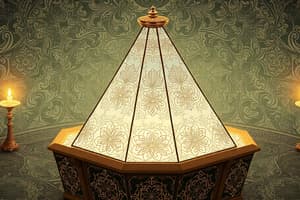Podcast
Questions and Answers
What is the formula to calculate the surface area of a triangular prism?
What is the formula to calculate the surface area of a triangular prism?
- Base Area × Rectangular Face Area
- Base Area × Height + Rectangular Face Area
- Base Area + Rectangular Face Area
- Base Area + 2 × Rectangular Face Area (correct)
How many square bases does a rectangular prism have?
How many square bases does a rectangular prism have?
- Two (correct)
- Five
- Four
- Three
Why is knowing the surface area important in packaging?
Why is knowing the surface area important in packaging?
- To minimize wasted space (correct)
- To increase cost
- To complicate the shipping process
- To make products heavier
When designing structures, why do architects calculate surface areas?
When designing structures, why do architects calculate surface areas?
What is the key component that defines a triangular prism?
What is the key component that defines a triangular prism?
In manufacturing, why do product designers determine the surface area of parts?
In manufacturing, why do product designers determine the surface area of parts?
Which of the following is NOT required to calculate the surface area of a triangular prism?
Which of the following is NOT required to calculate the surface area of a triangular prism?
What is the formula for finding the base area of an equilateral triangular prism?
What is the formula for finding the base area of an equilateral triangular prism?
How do you calculate the total surface area of a rectangular prism?
How do you calculate the total surface area of a rectangular prism?
Which of the following is a real-life application of understanding surface area?
Which of the following is a real-life application of understanding surface area?
Flashcards are hidden until you start studying
Study Notes
Surface Area: Understanding Triangular Prisms, Rectangular Prisms, Calculations, and Real-Life Applications
The term "surface area" refers to the total amount of space occupied by the outer boundaries of a given object. It is often expressed in terms of the square footage or square meters of an object's exterior surfaces. This concept plays a crucial role in geometry, especially when dealing with various types of prisms, such as triangular and rectangular ones. In this article, we will delve deeper into understanding surface area, focusing on the subtopics of triangular prisms, rectangular prisms, calculating surface area, and their real-life applications.
Triangular Prisms
A triangular prism is a polyhedron composed of one triangular base, two lateral faces, and one rectangular face. Each face can be represented by its side length(s), making it easier to calculate the surface area. The formula for the surface area of a triangular prism involves adding the areas of all five faces together. This can be accomplished by using the following steps:
- Find the base area of the triangle by multiplying its height by one side length (half of the other two side lengths if the triangle is equilateral).
- Multiply each side length of the rectangular face by its corresponding height to find each area.
- Add both the base area and the combined area of the two rectangular faces to obtain the total surface area of the triangular prism.
For example, if a triangular prism has a base with a height of 5 cm and two sides measuring 8 cm and 11 cm, we would calculate the surface area as follows:
Base Area = 8cm × 5cm = 40 cm² Rectangular Face Area = 8cm × 11cm = 88 cm² Total Surface Area = 40 + 88 = 128 cm²
Rectangular Prisms
Similar to their triangular counterparts, rectangular prisms are also polyhedra composed of two congruent square bases and six rectangular lateral faces. The formula for calculating the surface area of a rectangular prism involves summing up the areas of all six faces:
- Find the area of one square face by squaring any of its side lengths.
- Multiply this value by two to obtain the area of both square bases.
- Multiply each side length by its corresponding height for both rectangular faces.
- Add these values together to find the combined area of the six rectangular faces.
- Finally, add the area of both square bases and the combined area of the six rectangular faces to obtain the total surface area of the rectangular prism.
For example, consider a rectangular prism with dimensions of 6 cm × 7 cm × 4 cm:
Square Base Area = 6cm² Rectangular Face Area = 6cm × 4cm × 2 = 24 cm² Total Surface Area = 6 + 24 = 30 cm²
Real-Life Applications
Surface area calculations play an essential role in various real-life situations involving prisms. Some examples include:
-
Packaging: To ensure efficient storage and transportation, companies must determine the surface areas required for packaging their products. Knowing these dimensions helps them choose appropriate boxes or containers to minimize wasted space.
-
Construction: Architects and builders often calculate surface areas when designing structures, such as houses, skyscrapers, and other buildings. This allows them to estimate materials needed for roofing, walls, and floors based on the structure's dimensions.
-
Manufacturing: In the production process, product designers may need to determine the surface area of parts they manufacture, ensuring that the material used is sufficient for the given design specifications.
In conclusion, understanding the concept of surface area is crucial in mathematics, particularly when dealing with triangular prisms and rectangular prisms. By mastering the formulas and applications, we can apply this knowledge to real-world problems, making our lives easier and more efficient.
Studying That Suits You
Use AI to generate personalized quizzes and flashcards to suit your learning preferences.




